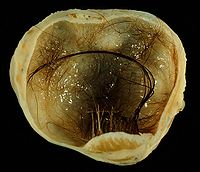
Photo from wikipedia
BACKGROUND Anti-N-methyl-D-aspartate receptor (NMDAR) encephalitis is an autoimmune encephalitis mediated by anti-NMDAR antibodies. Ovarian teratoma is closely related to anti-NMDAR encephalitis. However, the optimal treatment remains unknown and strategies used… Click to show full abstract
BACKGROUND Anti-N-methyl-D-aspartate receptor (NMDAR) encephalitis is an autoimmune encephalitis mediated by anti-NMDAR antibodies. Ovarian teratoma is closely related to anti-NMDAR encephalitis. However, the optimal treatment remains unknown and strategies used for the diagnosis and therapy, including surgical intervention of ovarian teratoma, are debatable. OBJECTIVE To study the clinical features of anti-NMDAR encephalitis with ovarian teratoma to further understand the disease. STUDY DESIGN This single-center prospective study included patients with anti-NMDAR encephalitis with ovarian teratoma from 2011 to 2016 who were admitted to Peking Union Medical College Hospital, Beijing, and discussed the clinical characteristics, treatment, and prognosis of the disease. The diagnosis of anti-NMDAR encephalitis was established preoperatively by identifying anti-NMDAR antibodies in the cerebrospinal fluid. Ovarian teratomas were suspected preoperatively by pelvic ultrasound and were diagnosed pathologically after laparoscopic detection and ovarian tumor resection. All patients were treated with first-line immunotherapy (steroids, intravenous immunoglobulin, and plasmapheresis), and when the therapy failed, they were treated with second-line immunotherapy (cyclophosphamide and rituximab). All patients were followed up regularly, and NMDAR antibodies, pelvic ultrasound, and neurological condition were monitored. Neurological symptoms were assessed using the modified Rankin Scale. RESULT A total of 108 female patients with anti-NMDAR encephalitis were screened, of whom, 29 patients (26.9% of 108; mean age ± standard deviation: 23.14 ± 6.59 years) had pathologically confirmed ovarian teratoma. The incidence of fever, decreased consciousness, arrhythmia, central hypoventilation, ventilator-assisted respiration, and intensive unit care (75.9%, 65.5%, 27.6%, 55.2%, 55.2%, and 58.6%, respectively) were significantly higher in patients with ovarian teratoma than in those without ovarian teratoma. The modified Rankin Scale at the acute onset in those 29 patients was 4.11 ± 1.20, which was also much higher than that in patients without ovarian teratoma (3.58 ± 1.08). Of the 29 patients with ovarian teratoma, 22 (75.9%) underwent laparoscopy during the acute onset of neurological symptoms. The mean diameter of the tumor was 4.61 ± 3.41 cm (standard deviation), and the smallest tumor was only 1 cm in the unilateral ovary. All other cysts, except four bilateral cysts (13.8%), were unilateral. Only one patient was diagnosed pathologically with immature ovarian teratoma, while others had benign ovarian teratomas. In all, 28 patients (96.5%) had a good outcome (modified Rankin Scale≤2) and one died. In the follow-up visit (mean duration: 37.69 months), the relapse rate of encephalitis in patients with ovarian teratoma undergoing laparoscopic cystectomy was 14.6%, whereas for those without ovarian teratoma, the relapse rate was 33.3%. The removal of ovarian teratoma was associated with 23% reduced risk of relapse. CONCLUSIONS Patients having anti-NMDAR encephalitis with ovarian teratomas tend to present more severe neurological conditions. The diameter of the tumor in these patients is not very large and could be as small as 1 cm, and thus, careful exploration should be considered during surgery. Most of the ovarian teratomas in patients with anti-NMDAR encephalitis are mature. Early operative treatment is safe and effective as it is associated with reduced risk of relapse and complete recovery.
Journal Title: American journal of obstetrics and gynecology
Year Published: 2019
Link to full text (if available)
Share on Social Media: Sign Up to like & get
recommendations!